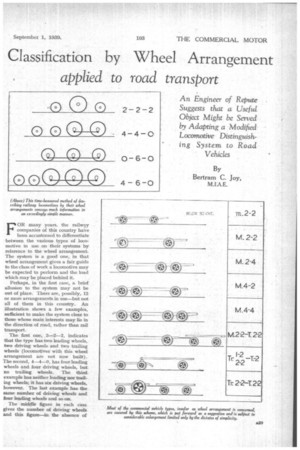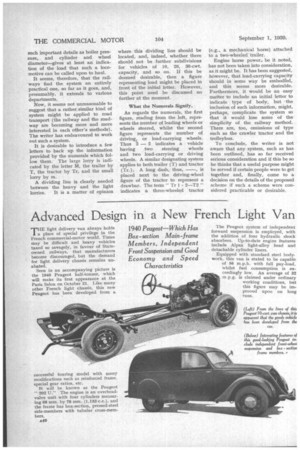Classification by Wheel Arrangement applied to road transport
Page 41

Page 42

If you've noticed an error in this article please click here to report it so we can fix it.
An Engineer of Repute Suggests that a Useful Object Might be Served by Adapting a Modified Locomotive Distinguishing System to Road
Vehicles
By Bertram C. Joy, M.I.A.E.
FOR many years, the railwa,y companies of this country haVe been accustomed to differentiate between the various types of locomotive in use on their systems by reference to the wheel arrangement. The system is a good one, in that wheel arrangement gives a fair guide to the class of work a locomotive may be expected to perform and the load which may be placed behind it.
Perhaps, in the first case, a brief allusion to the system may not be out of place. There are, possibly, 12 or more arrangements in use—but not all of them in this country. An illustration shows a few examples, sufficient to make the system clear to those whose main interests may lie in the direction of road, rather than rail transport.
The first one, 2-2-2, indicates that the type has two leading wheels, two driving wheels and two trailing wheels (locomotives with this wheel arrangement are not now built). The second, 4-4-0, has four leading wheels and four driving wheels, but no trailing wheels. The third example has neither leading nor trailing wheels; it has six driving wheels, however. The last example has the same number of driving wheels and four leading wheels and so on.
The middle figure in each case gives the number of driving wheels and this figure—in the absence of such important details as boiler pressure, and cylinder and wheel diameter—gives at least an indication of the load that such a locomotive can be called upon to haul.
It seems, therefore, that the railways find the system an entirely practical one, so far as it goes, and, presumably, it extends to various departments.
Now, it seems not unreasonable to suggest that a rather similar kind of system might be applied to road transport (the railway and the roadway are becoming more and more interested in each other's methods). The writer has endeavoured to work out such a system.
It is desirable to introduce a few letters to back up the information provided by the numerals which follow them. The large lorry is indicated by the letter M, the trailer by T, the tractor by Tr, and the small lorry by m.
A dividing line is clearly needed between the heavy and the light ' lorries. It is a matter of opinion
where this dividing line should be located, and, indeed, whether there should not be further subdivisions for vehicles of 10, 20, 30-cwt. capacity, and so on. If this be deemed desirable, then a figure representing load might be placed in front of the initial letter. However, this point need be discussed no further at the moment.
What the Numerals Signify.
As regards the numerals, the first figure, reading from the left, represents the number of leading wheels or wheels steered, whilst the second figure represents the number of driving, or load-carrying wheels. Thus 2 — 2 indicates a vehicle having two steering wheels and two load-carrying or driving wheels. A similar designating system applies to both trailer (T) and tractor ( Tr, ). A long dash, thus, —, is placed next to the driving-wheel figure of the tractor to represent a drawbar. The term" Tr 1 2—T2" indicates a three-wheeled tractor (e.g., a mechanical horse) attached to a two-wheeled trailer.
Engine horse power, be it noted, has not been taken into consideration, as it might be. It has been suggested, however, that load-carrying capacity should in some way be embodied, and this seems more desirable. Furthermore, it would be an easy matter to include an initial letter to indicate type of body, but the inclusion of such information, might, perhaps, complicate the system so that it would lose some of the simplicity of the railway method. There are, too, omissions of type such as the crawler tractor and the trolleybus.
To conclude, the writer is not aware that any system, such as has been outlined, has so far received serious consideration and if this be so he thinks that a useful purpose might be served if certain people were to get together and, finally, come to a decision on the details of the proposed scheme if such a scheme were considered practicable or desirable.




































































